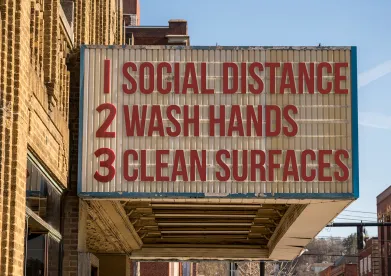The Occupational Safety and Health Administration (OSHA) published additional frequently asked questions regarding returning to the workplace during the COVID-19 pandemic on Thursday. We reported on OSHA’s earlier posted FAQs here. Though the FAQs do not impose any new legal requirements, employers should be aware of OSHA’s recommendations as workplaces around the country continue to reopen to workers, customers, and other visitors.
Cloth Face Coverings
Notably, OSHA recommends that employers encourage workers to wear face coverings while at work. OSHA maintains that employers must ensure social distancing in the workplace, even when workers wear cloth face coverings. This recommendation is consistent with the CDC’s recommendation that all people wear cloth face coverings in public and around others.
OSHA clarifies that employers have discretion to allow employees to wear cloth face coverings “based on the specific circumstances present at the work site.” For example, if chemicals are highly present in a workplace, cloth face coverings can become contaminated with the chemicals and pose a danger to employees. In such a case, employers might determine that cloth face coverings are actually a hazard to workers. Employers can then provide PPE instead of encouraging cloth face coverings.
OSHA also notes that employers should evaluate their “accessible communication policies and procedures” such as considering providing masks with clear windows to facilitate communication between workers and members of the public who rely on lip-reading.
Testing Positive
OSHA recommends workers inform employers if they have tested positive for COVID-19. When employers are notified that one of their workers tested positive, they should follow applicable CDC recommendations regarding community-related exposure, eventual return to work, and cleaning and disinfecting.
OSHA does not require employers to notify other employees if one of their workers tests positive. Still, employers must take appropriate steps to protect other workers from exposure, which may include notifying other workers to monitor themselves for symptoms, screening workers, and cleaning and disinfecting. The FAQs note that the CDC, on the other hand, recommends employers determine which employees may have been exposed and inform employees of such possible exposure.
Employers should keep in mind that they may not disclose confidential medical information under the Americans with Disabilities Act, and applicable federal, state, and local laws.
Construction and Healthcare Industries
The FAQs contain sections devoted to employers in the construction and healthcare industries. OSHA directs construction industry employers to its industry-specific guidance, and reminds these employers that OSHA’s requirements for respiratory protection in construction that were in place prior to COVID-19 remain in effect and have not changed.
OSHA directs healthcare industry employers to its previously issued guidance (here and here), as well as CDC guidance. OSHA’s healthcare industry guidance applies to healthcare provided outside of hospitals as well, such as through home healthcare, physical therapy, occupational therapy, and chiropractic care.
Worker Protection Concerns
Workers who are concerned their employers are not appropriately protecting them from exposure in the workplace are encouraged to speak with their employer. The FAQs remind workers that they have the right to file OSHA complaints in certain circumstances as well, including if they have been retaliated against for voicing concerns about a good faith belief regarding a health or safety hazard.
OSHA’s FAQs also remind employers of their responsibility to conduct a hazard assessment regarding exposure to hazardous chemicals used for cleaning and disinfecting. Based on the results, employers may need to provide PPE and implement a hazard communication program, in compliance with OSHA’s Hazard Communication Standard.





 />i
/>i
